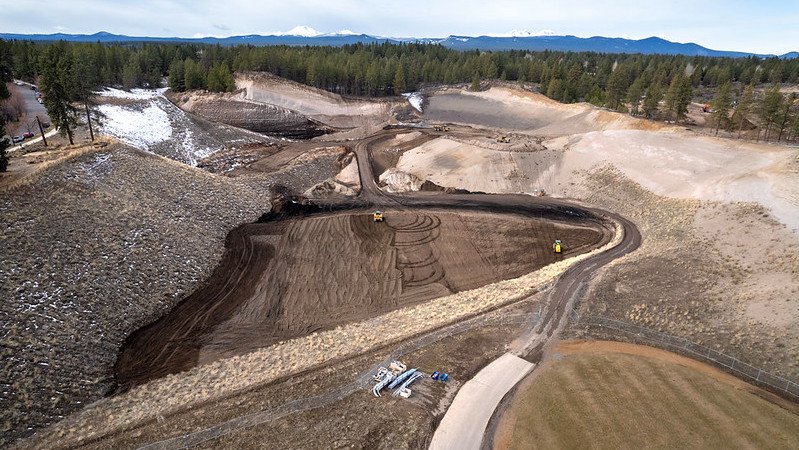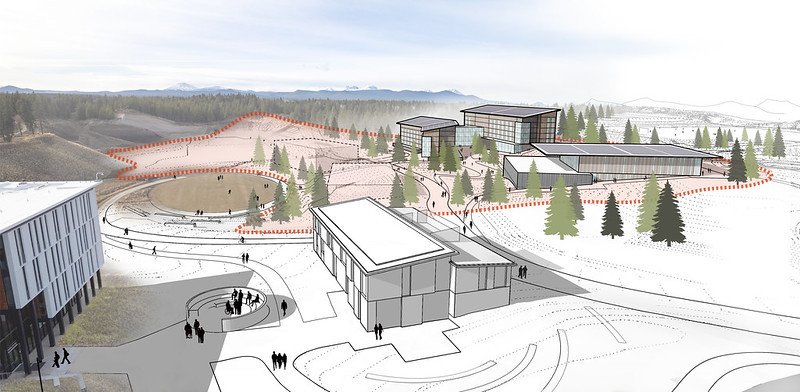OSU-Cascades asks state lawmakers for $24 million to speed remediation on Bend campus expansion site


(Update: Adding video, Sherm Bloomer interview)
Most of Bend campus is on former demolition landfill, pumice mine
BEND, Ore. (KTVZ) -- OSU–Cascades is seeking $24 million from the Oregon Legislature to expedite the next phase of its land remediation, which will provide space over the next decade to serve the growing campus’s academic, research and student housing needs.
“We are grateful for the Legislature’s support to date of OSU-Cascades’ development,” said Sherm Bloomer, chancellor and dean of OSU-Cascades. “Without it, and tremendous community support, the region would have remained a ‘higher education desert,’ unable to help meet the region’s educational attainment and economic needs.”
Bloomer traveled to Salem on Thursday to meet with lawmakers to discuss the funding request, along with community leaders and students.
OSU-Cascades is located on 128 acres, 118 of which comprise a former demolition landfill and pumice mine. More than 24 acres have been developed to date.
The funding being sought during the current legislative session would allow for 24 more acres to be remediated, creating 81 contiguous acres of campus land. The newly remediated land will provide space for up to seven buildings.
The school is seeking a cut in federal funds from House Bill 5201 to go toward converting the old landfill into a new, state-of-the-art campus.
Bloomer told us Tuesday, "It would give us 81 acres in the middle of campus, so it would be building space for at least in the next decade. It would let us build the next seven buildings, and most importantly, would let us keep turning out graduates that are going to contribute to the Central Oregon economy. And they're going to start businesses and business growth in Central Oregon.”
Remediation of OSU-Cascades’ undeveloped land involves reusing excavated and cleaned material from the landfill to then grade and fill the pumice mine to planned levels, as well as grade portions of the landfill. Engineers designed the approach to eliminate the need to import backfill material, eliminating 50,000 truck trips on area roads during the total remediation effort.
The funding request is supported by the Bend Chamber of Commerce and Economic Development for Central Oregon, as well as by the Beaver Caucus/Now4 OSU-Cascades, an advocacy group of alumni and community members.
Bloomer and community supporters pointed to how development-ready land can help OSU-Cascades meet regional workforce needs, particularly in key industries like advanced manufacturing, bioscience, and high tech that require bachelor’s degrees or higher. There are also plans for apartment-style student housing, for older students.
With nearly a decade of year-over-year record first-year enrollment, current student housing is nearing capacity. Campus planners forecast that additional on-campus housing will be needed for 150 students by 2026.
Campus planners determined expediting the next phase of land remediation as the current phase concludes makes engineering and economic sense, saving up to $1 million in costs that would be incurred due to overlapping activities.
Prepared land will also provide space for a health and recreation center, a facility that students voted in 2017 to direct an approved increase in student fees toward. Students are contributing at least $15 million towards the future building.
The land remediation currently underway was funded with a $24 million investment in from Oregon State University, $10 million in state funding, and a $2 million grant from the U.S. Environmental Protection Agency. OSU will also invest at least $3 million in the next phase.
About OSU-Cascades: Oregon State University’s campus in Bend brings higher education to Central Oregon, the fastest growing region in the state. Surrounded by mountains, forest and high desert, OSU-Cascades is a highly innovative campus of a top-tier land grant research university, offering small classes that accelerate faculty-student mentoring and experiential learning. Degree programs meet industry and economic needs in areas such as innovation and entrepreneurship, natural ecosystems, health and wellness, and arts and sciences, and prepare students for tomorrow’s challenges. OSU-Cascades is expanding to serve 3,000 to 5,000 students, building a 128-acre campus with net-zero goals.